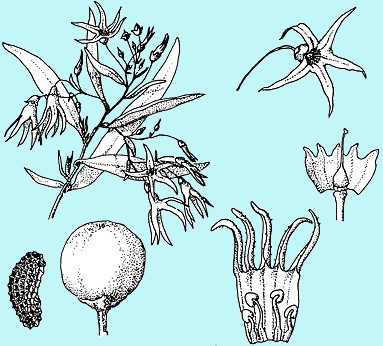
Synonymy
Duboisia leichhardtii (F. Muell.) F. Muell., Syst. Census Austral. Pl. 1: 97 (1883)
Anthocercis leichhardtii F. Muell., Fragm. Phytogr. Austral. 6: 142 (1868).
T: extra-tropical eastern Australia, Leichhardt s.n.; syn: K, MEL 71039.
Description
Tall shrub or small tree to 12 m; bark thick and corky towards base.
Leaves narrowly ovate-elliptic, rarely narrowly ovate or narrowly elliptic, almost sessile (or with petiole to 8 mm long), 5–13 cm long, 7–20 mm wide, concolorous.
Inflorescence broadly pyramidal; bracts 0.5–2.5 mm long; pedicels 10–16 mm long. Calyx 1.5–3 mm long, the lobes about half as long as tube. Corolla 13–19 mm long; tube 4–4.5 mm diam. at apex; lobes 6.5–11.5 mm long. Stamens 4, 2.5–4 mm long. Style 2.5–4 mm long, exceeding upper stamens by 0.5–1 mm.
Berry globose, 4–5 mm diam., purple-black; fruiting pedicels to 20 mm long. Seeds 2.5–3 mm long.
Distribution and ecology
Occurs in south-eastern and south-central Qld.
Grows in fertile loam, often in softwood scrub and in disturbed sites.
Notes
Reported to be toxic to cattle, horses and humans. Contains tropane alkaloids; harvested as a source of hyoscine for medicinal drugs.
A hybrid between D. leichhardtii and D. myoporoides R.Br. also yields tropane alkaloids and is cultivated commercially for hyoscine production.
Derivation of epithet
Named in honour of the collector or the type, the explorer Ludwig Leichhardt (1831-?1848).
Images and information on web
References to the possible toxic properties of Duboisia species can be found with a search in the FDA Poisonous Plant Database
A discussion of the tropane alkaloids which occur in Duboisia and other Anthocercideae can be found in Griffith & Lin (2000).
Ref: W.J. Griffin & G.D. Lin (2000). Chemotaxonomy and geographical distribution of tropane
alkaloids. Phytochemistry 53: 627–628.
An unpublished manuscript by Paul Foley, Prince of Wales Medical Research Institute,